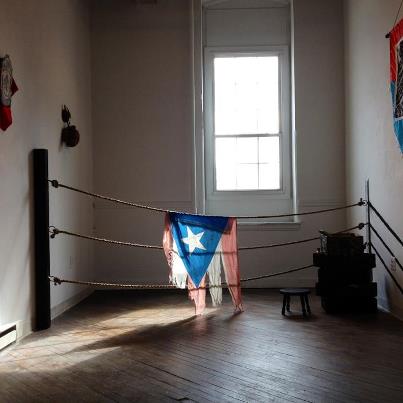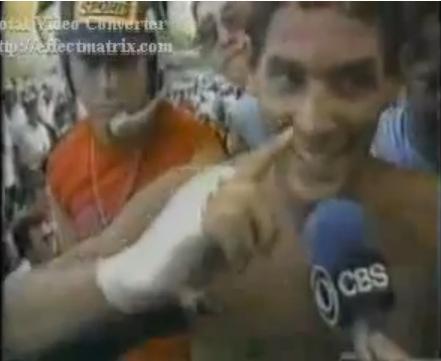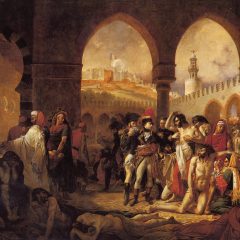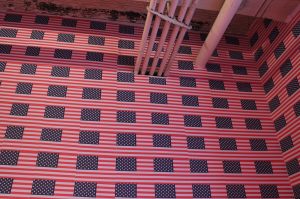A small temple in honor of the late Hector “Macho” Camacho, a Puerto Rican boxer from San Juan who always stayed close to his community, has been erected at Napoleon gallery in Philadelphia. Their latest outing, A Cemi Waste of Macho Time: something for us to believe in is the first installation piece by Philadelphia artist Grimaldi Baez. Not being a fan of boxing, I didn’t know about Camacho until I saw this show. After watching a YouTube video of Camacho winning his first world title in 1983 and hearing the crowd chant Camacho’s name, it became clear to me that he meant something special to people. That includes Baez, who replaced Jesus Christ with Camacho in his passionate if cartoony woodcuts that mimic the traditional Gospel compositions of Rembrandt and Durer.

Baez says he is not himself a sports fan, but is attracted by the worship that flowed to Camacho’s memory in the wake of his death. It is in this sense that the show’s title is drawn from the Taino concept of the “Cemi” idol. The Tainos were the natives of the Dominican Republic and Haiti (there were groups in Puerto Rico also) before the Spanish came and today, few of their descendants survive. The installation includes homage to their forms of worship as much as to the spirit of the boxer Camacho. While Tainos would create small idols of wood or stone as their cemis or zemis and rely on these objects for good fortune, people today are more likely to look at a personal hero in pop culture.

While the installation is open to interpretation, it immediately struck me as a place of mourning and remembrance of a great spirit – one edge is the corner of a boxing ring, with a stack of crates full of bananas, and a tattered Puerto Rican flag over the boxing ring ropes, clearly inviting us to view the entire gallery space as the stage where Camacho lived out his passion for boxing. Battered old boxing gloves hang on the wall, while nylon banners lining the walls bear woodcuts of Camacho fallen in the boxing ring like Jesus from the cross, like stained glass images in a chapel.

The sense of velocity and strength in the cuts of these prints speaks to the artist’s emotional connection to his subject. The figures in each piece – posed like stand-ins for the Apostles and Virgin Mary – are delineated with a series of vertical slashes. They resemble the wavy-lined black-and-white comics of Art Spiegelman or Frank Miller in stark contrast to the precise lines of the Durer, and Baez did draw inspiration from comic books in his early days. The images’ arrangement – in the show, on flags, and all depicting events around a central figure constantly wearing a frog mask – feels idolatrous. The hero is worshipped even as he is depicted in an impure manner. The absurd masculine “macho” energy can’t be taken seriously, thus the frog mask; yet the panicked expressions of the figures about him, their eyes all on Camacho, make him the central organizing principle of these images.

The mythological context of modern day hero-worship as it relates to celebrities like Camacho is both interrogated and celebrated here. The work feels flawed, until one realizes the sincerity is partly an act, commenting on how a heroic athlete’s young death –in this case from a shooting in November 2012, an act of street violence, which is still being mourned by some Puerto Ricans – can be as impactful as the Crucifixion. Whether this is wrong or right, or a mere symptom of contemporary TV culture, is up to the viewer. I felt impacted by Camacho as a real person and as an artist in his own right, significant enough to inspire these depictions. Baez, though, seems more detached and less involved with Camacho. Perhaps he is just using the figure of the real-life boxer to explore and illustrate his own ideas.

“A Cemi Waste of Macho Time” is effective as a “hallowed space,” but the woodcuts — overflowing, hyperactive images filled with characters and figures that depict moments akin to the stations of the cross — are the centerpiece of this work and leave the viewer speechless with awe. To learn Camacho’s rise, fall and his complicated story through Google and Wikipedia is one way to appreciate the ambiguities inherent in these woodcuts; why their black light seems almost demonic, and Camacho’s fall so inevitable. But as a new take on the age-old story of the hero’s rise and fall, they are inscrutable and tantalizing in their concealed loyalties and misleading messages.
A Cemi Waste of Macho Time: something for us to believe in, Grimaldi Baez at Napoleon Gallery, 319 N. 11th St., will be up until March 29.









